

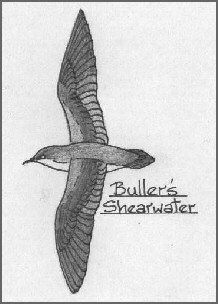
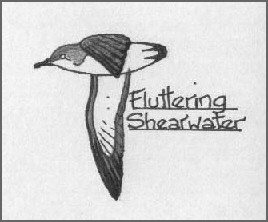
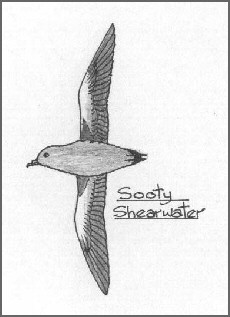
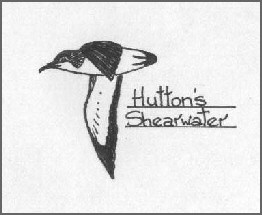
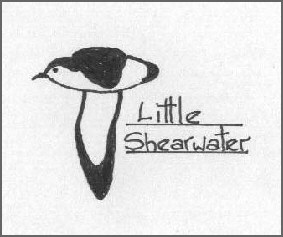
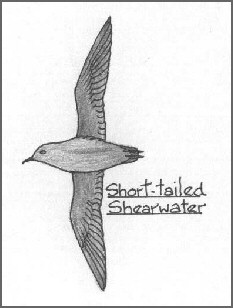
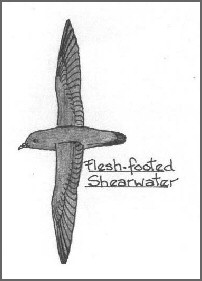
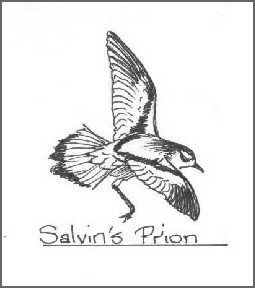
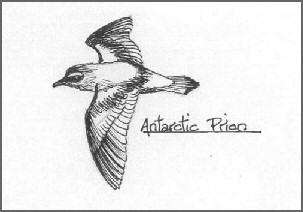
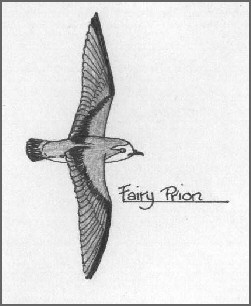
ON THIS PAGE YOU WILL FIND SHEARWATERS AND PRIONS. SCROLL DOWN TO FIND THE FOLLOWING BIRDS: BULLER'S SHEARWATER; FLUTTERING SHEARWATER; HUTTON'S SHEARWATER; LITTLE SHEARWATER; SHORT-TAILED SHEARWATER; FLESH-FOOTED SHEARWATER;
SALVIN'S PRION; BROAD-BILLED PRION; ANTARCTIC PRION; THIN-BILLED PRION; FAIRY PRION; FULMAR PRION.
SHEARWATERS
BULLER'S SHEARWATER / Rako Puffinus bulleri
A
large, 46cm, slender-bodied bird with a long tail and distinctive
'M' pattern on the upperwings. Underparts white. Flight
is graceful and gliding interspersed with strong wingbeats.They
breed in Summer in large numbers on the Poor Knights Islands and
are a common Summer resident in coastal NZ waters, especially in
the north. They were once taken as muttonbirds by northern
Maori.
FLUTTERING SHEARWATER / Pakaha Puffinus gavia
Medium-sized, 33cm, this bird has dark brown upperparts, white underparts and dark face. Their flight is low, rapid and direct, near the surface of the water. They are an abundant endemic and used to be taken as muttonbirds, which are young birds taken from nesting burrows. They are now protected. They breed on predator-free islands off the north-east coast of the North Island and also islands in the Marlborough Sounds. They often form large 'rafts' in calm coastal waters.

SOOTY SHEARWATER / Titi Puffinus griseas
A large, 44cm, all dark shearwater with dark bill and feet and pale silvery underwings. They have a distinctive fast-flapping flight with long glides. An abundant native, the Sooty Shearwater is the most commonly taken muttonbird in NZ. Many young birds, from hundreds to thousands, are taken from nesting burrows in May by southern Maori. The largest breeding colonies are around Stewart Island, Snares and Chatham Islands. NZ birds migrate to the North Pacific in the southern winter.

HUTTON'S SHEARWATER / Titi Puffinus huttoni
A medium sized, 36cm, shearwater, dark brown upperparts, white underparts, dark face, and brown mottling on the sides of the neck and chest. There is a dark patch on the inner underwing which is seen in flight. They fly with a low, direct, rapid flight near the surface of the water. They are a locally common endemic and breed at high altitudes in the Seaward Kaikoura Range. They range along the Kaikoura Coast to Cook Strait and the Tasman Sea. In winter they migrate to seas around Australia. Can be seen in feeding flocks close inshore off the Kaikoura and Nth Canterbury coasts and Banks Peninsula in Summer. Also on whale-watching trips and from Cook Strait ferries.

LITTLE SHEARWATER / Pakaha Puffinus assimilis
A small bird, 30cm, with black upperparts, white underparts and white face. The flight is stiff-winged, rapid and direct. A locally common native. There are 3 sub-species: the Kermadec Little, P.a.kermadecensis; North Island Little, P.a.haurakiensis; Subantarctic Little, P.a.elegans. These 3 sub-species are indistinguishable at sea. The Kermadec Little Shearwater breeds on the Kermadec Islands; the North Island Little Shearwater breeds on islands off the east coast of the Nth Island from the Bay of Islands to East Cape. The Subantarctic Little Shearwater breeds around the Antipodes Islands and the Chathams.

SHORT-TAILED SHEARWATER Puffinus tenuirostis
A medium to large bird, 42cm, all dark with dusky-grey underwings and a short tail. Bill and feet dark. A locally common migrant, the young of these birds are harvested on Bass Strait islands of Australia. Their flight is a fast flap and glide sequence, with much wheeling and plunging in bad weather. Found as beach wrecks around the NZ coast as the birds pass through NZ waters on their Spring and Autumn migrations.

FLESH-FOOTED SHEARWATER / Toanui Puffinus carneipes
A large, 44cm, all dark shearwater and distinctive pink feet. Bill pale-pinkish with a dark tip. They have a slow-flapping, buoyant flight. A common native they breed on a number of islands off the north-east coast of the Nth Island, the Auckland west coast, Taranaki and Cook Strait. They also breed in large numbers on Lord Howe Island and some Indian Ocean islands. They migrate to the North Pacific during the southern winter. They can often be seen scavenging bait from fishing vessel lines.

PRIONS
SALVIN'S PRION Pachyptila salvini
A small prion, 27cm, with blue-grey upperparts and white underparts. There is a blackish 'M' pattern on the upperwings and a narrow black tip to the tail. The bill is bluish, stout, broad and with visible lamellae at the base. It is a common visitor and arrives in NZ waters in Winter and Spring from the sub-antarctic Indian Ocean islands where it breeds. Commonly found as beach wreck on western and southern NZ coasts.

BROAD-BILLED PRION / Parara Pachyptila vittata
This is the largest Prion, 28cm, and has blue-grey upperparts and white underparts. There is a black 'M' pattern across the upperwings and a narrow black tip to the tail. The dark head has a distinct white eyebrow and a very broad grey bill with clearly visible lamellae. Probably the easiest Prion to identify at sea with distinctive features such as large size, large head, robust bill and high forehead. They fly more slowly than other Prions and glide more. They are a locally common native and breed on South Atlantic and southern NZ islands and the Chatham Islands. The Broad-billed Prion is a threat to the small population of Chatham Petrels through competition for nesting burrows.

ANTARCTIC PRION / Whiroia Pachyptila desolata
A large Prion, 26cm, with blue-grey upperparts and white underparts. They have a dark 'M' pattern across the upperwings and a narrow black tip to the tail. The bill is bluish, stout and broad but with no visible lamellae visible. A locally common native, Antarctic Prion breed on island groups in the Antarctic and sun-antarctic regions, and the Auckland Islands. They are a regular visitor to southern NZ waters in Winter and Spring.

THIN-BILLED PRION Pachyptila belcheri
Size 26cm, with blue-grey upperparts and white underparts. This Prion has a paler face and more prominent white eyebrow than the other Prions. The 'M' pattern on the upperwings is less distinct than other Prions and the bill is slender. They have a narrow black tip to the tail. They are a common visitor to NZ and breed in the sub-antarctic Atlantic and Indian oceans. They regularly reach NZ in Winter and Spring, and are often found as beach wreck.

FAIRY PRION / Titi-wainui Pachyptila turtur
The smallest Prion, 25cm, with blue-grey upperparts, white underparts, bold 'M' pattern on upperwings and broad black tip to the tail. The stout bill is blue. A locally abundant native this is NZ's most common Prion and the most abundant tuber-nose species found as beach wrecks. Although they do not follow vessels they are often attracted to ship lights at night. They breed on many sub-antarctic islands and in the NZ region they breed on many rodent-free off-shore islands from Poor Knights south, Snares and Chathams. They range widely in NZ waters and north into subtropical seas.

FULMAR PRION Pachyptila crassirostris
Size
26cm, with blue-grey upperparts, white underparts and broad black
tip to the tail. There is a bold black 'M' pattern across
the upperwings. Bill blue and stout with a large nail. A
locally common native but probably the rarest Prion on a global
scale. They breed in the South Indian Ocean and NZ regions. The
main NZ breeding sites are Chatham, Bounty, Snares and Auckland
Islands.











